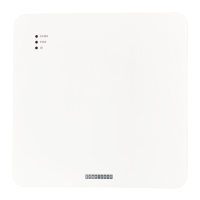Chapter 4
| Wireless Settings
Radio Settings
– 66 –
Selecting Auto enables the access point to automatically select an unoccupied
radio channel. (Default: Auto)
WME Configuration — Wireless Multimedia Extensions (WME), also known as
Wi-Fi Multimedia (WMM), is a Wi-Fi Alliance interoperability certification,
based on the IEEE 802.11e standard. It provides basic Quality of service (QoS)
features for IEEE 802.11 networks. Access priority can be configured for four
“Access Category”(AC) types using the following parameters:
CW Min (Minimum Contention Window) – The initial upper limit of the
random backoff wait time before wireless medium access can be
a
ttempted. The initial wait time is a random value between zero and the
CWMin value. Specify the CWMin value in the range 0-15 microseconds.
Note that the CWMin value must be equal or less than the CWMax value.
CW Max (Maximum Contention Window) – The maximum upper limit
of the random backoff wait time before wireless medium access can be
attempted. The contention window is doubled after each detected collision
u
p to the CWMax value. Specify the CWMax value in the range 0-15
microseconds. Note that the CWMax value must be greater or equal to the
CWMin value.
AIFS (Arbitration Inter-Frame Space) – The minimum amount of wait
time before the next data transmission attempt. Specify the AIFS value in the
range 0-15 microseconds.
TXOP Limit (Transmit Opportunity Limit) – The maximum time an AC
transmit queue has access to the wireless medium. When an AC queue is
g
ranted a transmit opportunity, it can transmit data for a time up to the
TXOP Limit. This data bursting greatly improves the efficiency for high data-
rate traffic. Specify a value in the range 0-8192 microseconds.
Beacon Interval — The rate at which beacon signals are transmitted from the
access point. The beacon signals allow wireless clients to maintain contact with
the access point. They also carry power-management and other information.
(R
ange: 100-1024 TUs; Default: 100 TUs)
Bandsteering — When enabled, clients that support 2.4 GHz and 5 GHz are
first connected to the 5 GHz radio. This feature helps balance the client load
over the two radio bands. Note that both radios must have configured SSIDs
and security settings that match for this feature to fully operate. (Default: Off)
Airtime Fairness — Enabling this feature improves the overall performance of
the wireless network. (Default: Disabled)
Minimum signal allowed — Only allows clients to connect to the radio
interface if their signal strength (RSSI) is equal or greater than the specified
value. Setting the value to -100 disables this feature. Clients already connected
are checked periodically. (Range: -1 to -100; Default: -70)

